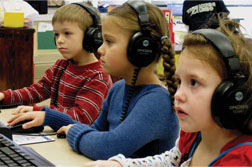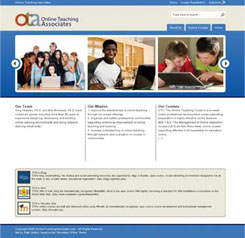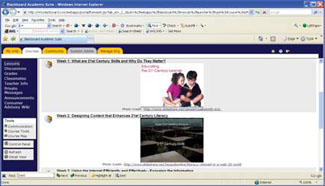The Blended Classroom Revolution: Virtual Technology Goes to School

Science-fiction aficionados and mainstream media can’t help themselves when it comes to the hype surrounding the emergence of virtual schools. It’s a sexy topic, full of controversies around unions, home schooling, and privatization—the juicy issues that make for fiery education debates. But the buzz around virtual schools, which currently serve only a tiny fraction of the nation’s 48 million K-12 students, misses the much bigger,
NEEL PATIL largely untold story unfolding in America’s brick-and-mortar classrooms: a simple yet profound merger is taking place between virtual-school technology and the traditional classroom.
The overwhelming majority of students will continue to attend physical schools, but an increasing number of students also will take courses, or parts of them, online, moving seamlessly between the traditional and virtual, says Bill Tucker, chief operating officer at Education Sector (Washington, DC), an independent think tank that challenges conventional thinking in education policy. Tucker is describing what is known as the blended model. And he is not alone in his enthusiasm for the approach.
“This is not creative fiction, speculation, or ‘wishful thinking,’” says Robert Blomeyer of Lisle, IL-based Blomeyer & Clemente Consulting Services, a firm that specializes in evaluations for improving online teaching and learning programs. “Online learning environments used to improve and broaden educational opportunities in traditional schools.” However, Blomeyer adds, “the phenomenon is happening in a relatively limited number of schools and school districts.” Blomeyer believes that with a little more work on school technology infrastructure, such as additional IP access in classrooms and more laptop computers, along with proper professional development to convert more certified teachers into facilitators of online learning, the blended model can work for many more schools.
Experts such as Blomeyer don’t view online learning as a delivery system competing with traditional K-12 schools. Rather, Blomeyer sees virtual learning technology as “essentially about educational improvement, school reform, and improving academic performance.”
A Blended VOISE
To the proponents of the blended model, the debate about whether virtual school technology can successfully be used to improve the quality, equity, and efficiency of teaching in the public schools is largely over. As the first decade of the 21st century comes to a close, attention has shifted to whether or not (and when) large numbers of America’s teachers will begin using it.
Tools and ideas to transform education. Sign up below.
Across the country, schools are taking aggressive steps to bring the blended model into the mainstream. Take Chicago’s VOISE Academy (Virtual Opportunities Inside a School Environment), a new, small performance high school based on a hybrid model of virtual technology and face-to-face teacher instruction. At VOISE, students receive a rigorous online curriculum in high-tech labs. The mission, according to Sandi Atols, manager of distance learning in Chicago’s Office of High Schools and High School Programs, is to provide all students with choice, flexibility, scholarship, and individual attention. They do this by combining technology, best distance-learning practices, quality online curriculum, exemplary classroom teachers, and a student-centered philosophy. “We’ve created a safe, academically successful school within a positive, interactive, technologically advanced environment,” says Atols.
VOISE Academy, which opened in the fall of 2008 in Chicago’s economically challenged Austin neighborhood, serves approximately 150 ninth-grade students. Atols expects to expand to 600 students within the next several years. Students at VOISE attend school for eight periods each day in seven faculty-staffed labs with high-end technology and broadband Internet access. They study math, science, social studies, and other traditional subjects. Teachers are ready to assist students with reading, resources, technology support, and specialized services. Students also have access to online courses 24/7 from computers provided for home use. “By providing courses online, we can teach students at their particular level, rather than follow a mass factory model where every student has to learn in lockstep,” says Atols. “By using a blended approach, we’re allowing each student to progress at their school level, instead of waiting for someone to catch up or be left behind as the class moves forward.”
Students at VOISE use Pittsburgh-based Carnegie Learning’s Cognitive Tutor for math instruction and Safari CPS-on-Demand, a broadcast-quality, plug & play, video-on-demand server, to access educational videos and lesson plans. Teachers, meanwhile, use Web-based software training from Atomic Learning (Little Falls, MN) to increase their knowledge and improve instruction. “The atmosphere at VOISE Academy is
Students work in a blended learning environment at North Hill Elementary School. unique,” says Atols. “The students are happy. They sit and work and collaborate. They’re using technology and taking to it like ducks to water. They are energized by the whole experience. There’s a buzz that happens in this school, and students are learning independently.”

Satisfaction is a catalyst for building knowledge in VOISE students. The Academy is breaking down barriers to student achievement while educating teachers and the community about the importance of learning and applying technology to increase academic achievement.
Universal Language
While the VOISE Academy is teaching hundreds of students under the blended model, many districts are applying the blended approach to meet the educational needs of one child or a small group of students. For instance, the principal at North
Screenshots from Online Teaching Associates Ltd. (www.onlineteachingassociates.com), offering standards-based online professional development for teachers and educational leaders. Lincoln Hill Elementary School (Philipsburg, PA), Patrick Hockey, has offered online technology to students in Philipsburg Osceola Area School District’s brick-and-mortar elementary school. Hockey recently used online courseware technology (originally developed for use in the district’s virtual school) to enable a mathematically advanced third grader to take accelerated math courses online without leaving her traditional classroom.

Hockey explains, “Many parents don’t like the idea of sending their young children to the junior high school. Instead of having to physically transport her across town to the junior high, we allowed the student to use a laptop to do her coursework while her classmates did theirs. Everyone benefits under this scenario.”
Hockey also points to other cases where the virtual model was applied to the traditional classroom. For example, Hockey says, it’s difficult to find a teacher certified to teach Mandarin Chinese for the three or four students in the district interested in learning the language. By tapping into a virtual course, he’s able to offer this type of instruction to students. “The only way I can accommodate certain requests is to ‘tear down the walls’ and allow students to go wherever they need to get the instruction that’s appropriate for them. If we blindly adhere to the traditional model—if we don’t tear apart and reconstruct using a hybrid approach—we’re not going to be able to survive as a society in the global market. We've got to be willing to say, ‘[traditional] education is failing right now.’ We’ve got to look at different models and new ways to get appropriate education for these kids. Public education is starting to see some of the great things that cyber charter schools have been doing—now we're playing catch-up.”
Difficult-to-find foreign language instructors seem to be a universal catalyst for the adoption of online learning in traditional school settings, especially in small and rural districts. In Karval, CO, a small town on the eastern plains of the state, foreign language courses—Chinese or otherwise—are not offered.
This is especially problematic for Karval students interested in attaining a college degree, as many of the state’s colleges now require at least one credit of foreign language to enroll. “For our brick-and-mortar students, we couldn’t get a foreign language teacher in the classroom, but we can access a virtual one using an online program,”says Sharla Book, online education director for the school.

Book uses online courseware provided by the American Education Corporation (Oklahoma City, OK) to teach foreign languages to Karval’s college-bound students. “Now that Karval has stepped into the virtual realm,” says Book, “we’ve been able to offer a wider variety of classes to a minimum number of students. Today, students can take foreign language online and meet college entrance requirements.”
Christian Dickinson, an instructional leader in St. John’s County, FL, has also turned to virtual school technology to provide students in his district with access to coursework that would otherwise be inaccessible, “especially the foreign language courses that can't be offered at the school, such as German, Latin, Chinese, and Japanese.”
Dickinson adds, “As educators, our clients are the kids. The kids are savvy, and we have to meet their needs. Students that are not being offered online school courses are not being properly prepared for college. Today, if a student graduates from high school without having taken a single virtual school class, I don’t think they’re being prepared for the next level.”
Whether due to the demand for foreign language credits or the obvious educational benefits, the steady adoption of virtual school technology in mainstream classrooms seems assured. “The blended learning model is the ‘killer application’ of online education,” says Liz Pape, president and chief executive officer of Maynard, MA-based Virtual High School, a non-profit organization that offers content-rich, credit-bearing high school courses to students. “It enables classroom teachers to teach in a 21st century model that is more engaging to students.”
--By Marty Weil, Contributing Editor
